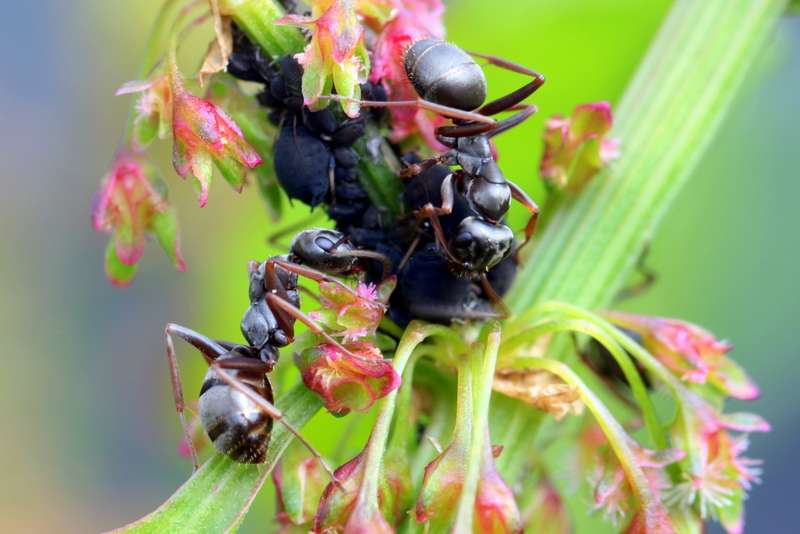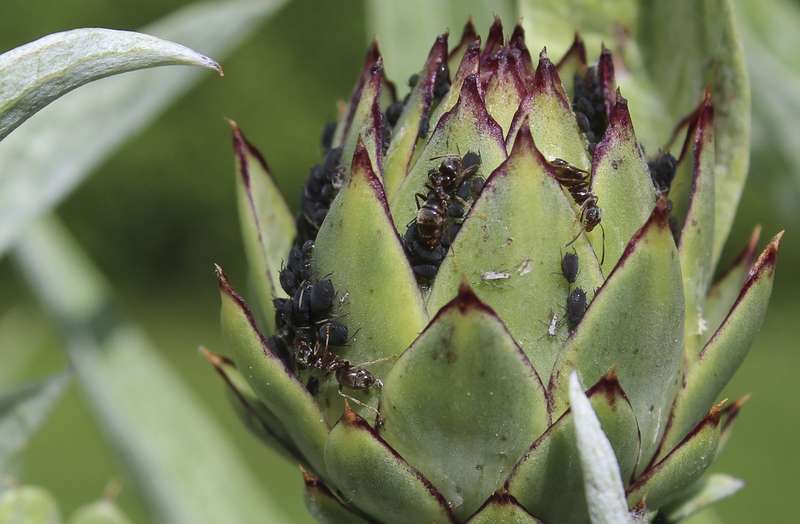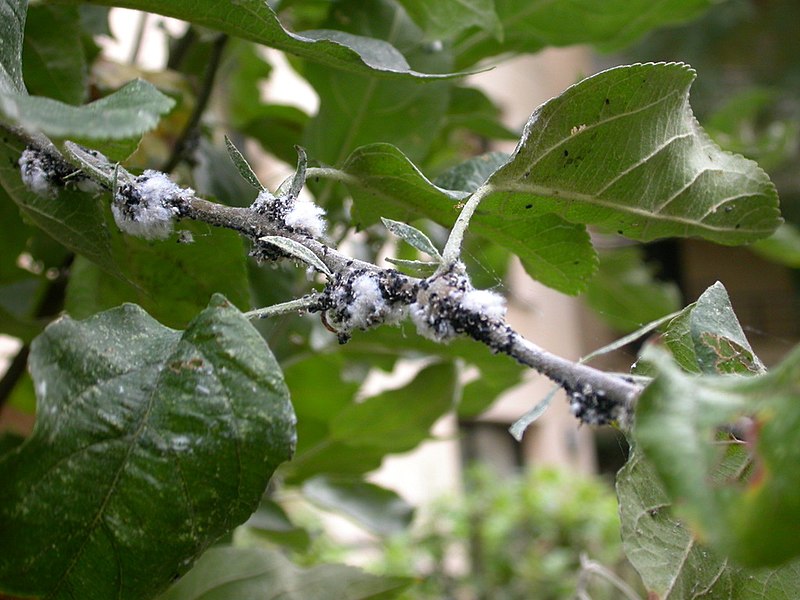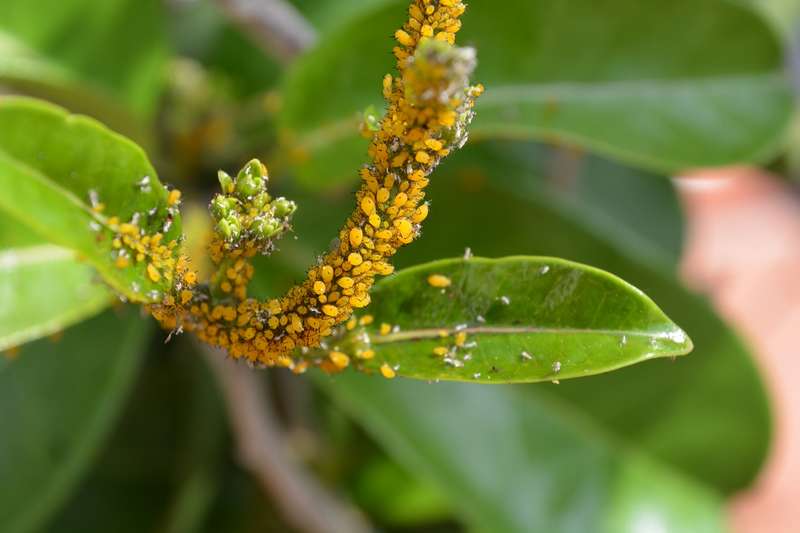The aphid is a well-known insect that populates our gardens where it forms colonies on various ornamental, vegetable or fruit plants. Gardeners often observe these colonies of black aphids on cherry trees or green aphids on roses, among others.
An aphid infestation is not necessarily a problem: with a little patience, the garden’s natural enemies will take care of it and eventually get rid of it within a few weeks. Nevertheless, aphids can cause damage to young plants and shoots of the year, requiring intervention. For this, there are natural, organic anti-aphid solutions to allow you to fight effectively in order to reduce the outbreaks harmful to your crops and plantations.
Aphids are small, soft-bodied insects that can infest a variety of plants, both indoors and outdoors. They often feed on the sap of plants and can cause damage to leaves, flowers, and stems. Identifying and treating aphids is important for maintaining the health of your plants. Here’s how to identify and treat aphid infestations:
Identification:
- Appearance: Aphids are typically small, ranging from 1/16 to 1/8 inch in size. They can be green, yellow, brown, black, or even pink. They have soft bodies and long, slender mouthparts for piercing and sucking sap from plants.
- Location: Aphids are often found on the undersides of leaves and near new growth, but they can infest various parts of a plant, including stems and flowers.
- Signs of Damage: Look for signs of aphid damage, such as distorted or curling leaves, yellowing, and sticky honeydew residue on leaves or the ground. Honeydew is a sweet, sticky substance excreted by aphids.
Treatment and Control:
- Prune and Remove: Prune and remove heavily infested parts of the plant. Dispose of the infested material to prevent the aphids from spreading.
- Water Spray: A strong stream of water from a hose can dislodge aphids from plants. Repeat this process regularly.
- Insecticidal Soap: Insecticidal soap is an effective and environmentally friendly way to control aphids. Mix a solution following the product instructions and spray it directly on the aphids. The soap disrupts their cell membranes, causing them to dehydrate.
- Neem Oil: Neem oil is a natural insecticide that can deter and kill aphids. Mix neem oil with water and a small amount of dish soap to make a spray. It can also interfere with aphid feeding and reproduction.
- Beneficial Insects: Introduce or attract natural predators of aphids, such as ladybugs, lacewings, and parasitic wasps, to your garden. They can help control aphid populations.
- Plant Companion Plants: Certain plants, like marigolds and nasturtiums, can deter aphids from nearby plants.
- Diatomaceous Earth: Sprinkle food-grade diatomaceous earth around the base of plants to create a barrier. When aphids crawl over it, the sharp particles will damage their bodies, causing them to dehydrate and die.
- Systemic Insecticides: For severe infestations, consider using systemic insecticides, which are absorbed by the plant and kill aphids when they feed on the plant’s sap. Use these with caution, and follow label instructions.
- Regular Monitoring: Continue to monitor your plants for aphids and take action as soon as you detect an infestation. Early intervention is key to preventing the infestation from spreading.
It’s important to maintain a healthy garden, as healthy plants are less susceptible to aphid infestations. Proper watering, fertilization, and overall plant care can help prevent aphids and other pests from becoming a problem. Integrated pest management (IPM) practices, including using beneficial insects and natural remedies, can also be part of a comprehensive approach to controlling aphids.
Contents
The Different Types Of Aphids
Black aphids, green aphids, aphids on roses or tomatoes… there are several hundreds of species of aphids on cultivated plants but fortunately few of them cause real damage in gardens. Aphids are biting and sap-sucking insects, particularly virulent in hot weather. They attack almost all cultivated plant species and their size varies between 2 and 4 mm. They are often found in colonies under the leaves, at the end of the branches or on the peduncles of the flowers. Certain species have a cycle of development which is made on several successive plants. That is to say that in the same season, they pass from a primary host plant to one or more secondary host plants.
Almost all species overwinter as eggs laid on leaves or in the soil. These eggs will give birth to female aphids that form the first colonies. They then reproduce by parthenogenesis. Some individuals are provided with wings to be able to colonize other plants. Males are present in autumn to allow sexual fertilization, before the eggs are laid.
Aphids are exploited by ants for their honeydew secretion and go so far as to protect their breeding by attacking the auxiliaries which would approach a little too closely.

Here are some of the most frequently encountered species:
Black bean aphid (Aphis fabae)

This species passes on several successive host plants. It is first found on fusain, viburnum and then from April on vegetable crops: bean, beet, cucumber, bean, artichoke, rhubarb but also on poppy, dahlia, nasturtium, etc…
Black cherry aphid (Myzus cerasi)
Its stings cause early curling or twisting of the leaves, as well as deformation of the branches. It secretes a sweet and sticky honeydew that causes burning, drying of the leaves and a significant reduction in production. Fumagin can also appear.
Green aphid (Myzus persicae)
The primary hosts of this species are fruit trees of the genus Prunus, especially peaches. It then migrates to vegetable crops: potato, tomato, bell pepper, lettuce, chicory, spinach, cabbage, carrot, cucumber, melon, zucchini, etc…
Green rose aphid (Macrosiphum rosae)
It develops on young shoots, flower buds or on the underside of leaves. There is no need to worry in a garden that is favourable to beneficials, as they regulate aphids very well. Keep an eye on young roses, however.
Cabbage aphid (Brevicoryne brassicae)
As the name suggests, this aphid attacks cabbage specifically and is favored by hot, dry weather. It is light green with a white downy covering and often invades cabbage from May to October. If the aphids are in large numbers, damage can be severe on seedlings and young cabbage plantings.
Ashy apple aphid (Dysaphis plantaginea)
This species can be recognized by its whitish pulverization, the winged individuals being black. It is the most dangerous aphid, especially on young trees. In the spring, leaf curling, twig and fruit deformations are quickly observed.
Woolly apple aphid (Eriosoma lanigerum)

Its excessive presence results in the formation of swollen cankers on the carpenter branches and the weakening of the trees. It can be recognized by the whitish wax that covers it. It overwinters in the folds of the bark in the lower part of the trees, up to the roots.
Root aphid (Pemphigus bursarius, Protrama flavescens…)
These species attack several vegetable plants at the root level, in particular salads which hardly pump and sometimes die.
Yellow aphid (Cryptomyzus ribis)

It is often present in spring, under the leaves. Its sting causes characteristic blisters and the appearance of reddish colors that can be easily observed on blackcurrant leaves for example. This aphid is rarely dangerous for plants. It is also present on oleanders.
The Damage Caused
In the garden, when an aphid attack occurs, we generally observe :
- a slowing down of the growth,
- a deformation of the leaves,
- the development of fumagine, a disease that results in the appearance of a black and sticky substance on the leaves and fruits,
- a decrease in fruit production,
- an increased risk of diseases because aphids, by biting plants to feed, can transmit many viruses such as cucumber mosaic for example.
Mechanical Control
The first way to fight against aphids is mechanical control. It consists in :
Disperse the aphid colonies with the help of a water jet (hose or sprayer),
Crushing the aphids by hand… which is slow and tedious!
For fruit trees, the use of a glue ring placed on the trunk and on the tree’s stake is often recommended. This device, designed to mechanically trap ants, also captures other useful insects. Do not overuse it and, if you use these strips of glue, leave them in place only from April to June.
Natural Aphid Control Treatments
There are not always enough beneficial insects to control aphid populations and in case of massive outbreaks, several solutions are available.
Act gradually, depending on the severity of the attack, by spraying :
A solution of black soap at a rate of 15 to 30 g for one liter of water, as soon as the first attacks occur.
An insecticide based on plant pyrethrum, as a last resort.
On fruit trees, apply a whitewash based on lime on the trunk and the carpenters the winter following a year of heavy pest invasion (and not systematically every year or two). This will destroy most of the overwintering aphids but not only.
Before anything else, we advise you to check beforehand if there are no auxiliary insects (larva or egg-laying) present on the plant. Black soap, paint and insecticides are not selective, they will also kill the beneficials.
Some gardeners also use infusions of garlic cloves, decoctions of wormwood or tansy or even peppermint purin. However, at the present time, their effectiveness has not been scientifically proven.
Biocontrol Solutions
It is possible to buy in some garden centers or through the Internet, auxiliaries to be introduced in the garden in order to fight against pests. For the amateur gardener, the introduction of an auxiliary is delicate: it is necessary to choose the right species, the best adapted to the problem to be treated, to introduce it at the right time and in adequate quantity.
This solution is particularly well adapted in greenhouses or verandas. At Promesse de fleurs, lacewing larvae are working efficiently in our greenhouses.
Beneficial insects introduced into a garden will only stay and survive if they find all the right conditions for their development throughout the year. Otherwise, they will die or leave. It goes without saying that after introduction, the use of any chemical or biological product (insecticide, sulfur, black soap…) should be avoided.
In a garden, it is much more efficient, sustainable and less expensive to attract native beneficials present in the environment by installing insect hotels.
Prevention
The best prevention against aphid invasions is to create a biologically balanced garden. Indeed, although it may come as a surprise, aphids are useful in the garden because they serve as a pantry for beneficial insects which, well fed throughout their life cycle, are more numerous to fight effectively against fruit and vegetable pests, the plants that really need to be protected. Reduce their population, yes… eradicate them, no! So leave aphids on ornamental and wild plants.
Also note that aphid colony development is often a sign of excessive plant vigor and an imbalance in sap composition. Avoid excess nitrogen-rich fertilizers.
To create a good balance in the garden:
Plant ground covers that provide shelter for beneficials, including ladybugs.
Plant a bed of phacelia and borage in the vegetable garden early in the spring, which will bloom from the beginning of June. These flowers attract hoverflies which are predators of aphids.
Encourage the permanent presence and winter survival of beneficial insects so that they can intervene as soon as possible in early spring and stop outbreaks: hoverflies, ladybugs, lacewings, microgreens, midges, chickadees, earwigs by installing shelters, insect hotels and nesting boxes.
Plant many flowers around the garden and among the vegetables and leave “relay” plants invaded by aphids (camomile, nasturtium, foxglove…).


